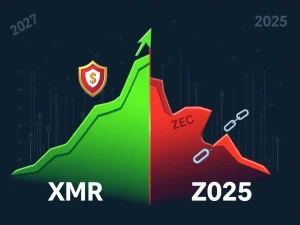Unlocking Strategic Crypto Presales: A Deep Dive into BitLemons, Bitcoin Hyper, and Remittix Opportunities

The cryptocurrency market is constantly evolving, presenting investors and entrepreneurs with exciting, yet complex, opportunities. In the fast-paced world of digital assets, identifying projects with genuine potential is paramount. Today, the spotlight is on specific crypto presales that are attracting significant capital, signaling a shift in how savvy investors are approaching value creation in the blockchain space. This article dives into three prominent projects – BitLemons (BLEM), Bitcoin Hyper (HYPER), and Remittix (RTX) – each offering a distinct approach to the future of decentralized finance.
What Are Strategic Crypto Presales and Why Do They Matter?
Crypto presales represent an early-stage investment opportunity, allowing participants to acquire tokens before they are publicly listed on exchanges. Think of it like getting in on the ground floor of a promising startup, similar to an initial public offering (IPO) in traditional markets. For entrepreneurs and early adopters, presales offer the allure of significant returns if the project succeeds. However, they also come with inherent risks, as many projects do not reach their full potential.
The appeal lies in:
- Early Access: Acquiring tokens at a potentially lower price point than their future market value.
- High Growth Potential: If the project gains traction, early investors can see substantial appreciation.
- Community Building: Presales often foster a strong community of early supporters who are invested in the project’s success.
Understanding the underlying value proposition of each project is crucial for making informed decisions in this high-stakes environment.
BitLemons: A Unique Crypto Investment Strategy with Operational Revenue
Among the emerging projects, BitLemons (BLEM) stands out due to its distinctive crypto investment strategy. Unlike many crypto ventures that rely solely on future adoption or speculative growth, BitLemons operates with a fully functional, revenue-generating business model from day one. It’s a crypto casino utilizing a robust GambleFi protocol, offering over 8,000 games through partnerships with industry leaders like Evolution and Pragmatic.
Key aspects of BitLemons’ approach:
- Real Revenue Generation: The platform generates income 24/7 through its gaming operations, providing a tangible financial foundation.
- Deflationary Tokenomics: A significant 30% of its Gross Gaming Revenue (GGR) is reinvested into the ecosystem. This includes token buybacks and burns, which reduce supply, and staking rewards, which incentivize holding. This mechanism is designed to systematically support token value.
- Strong Funding & Security: BitLemons has already raised $2,060,560, including a substantial $1 million private seed round. Dual security audits by SpyWolf and SolidProof further validate its structure and enhance investor confidence.
- Market Potential: The global online casino market is vast, estimated at $450 billion, offering a clear and expansive growth runway for BLEM as the crypto casino sector continues to expand.
The project’s current presale dynamics show growing momentum, with Stage 3 pricing at $0.03 and projected listing prices potentially reaching $0.17–$0.18, indicating a strong upside for early participants.
Decoding Bitcoin Hyper’s Layer-2 Promise and Risks
Bitcoin Hyper (HYPER) presents a different facet of crypto innovation, focusing on enhancing the Bitcoin network’s capabilities. It leverages SVM rollup technology, aiming to bring Solana-like transaction speeds to Bitcoin. This ambitious technical endeavor promises sub-cent token entry points and high APY staking rewards, appealing to those seeking high-performance solutions within the Bitcoin ecosystem.
However, Bitcoin Hyper’s success is contingent on several factors:
- Bitcoin’s Price Trajectory: As a Layer-2 solution for Bitcoin, its long-term viability is inherently tied to the performance and stability of Bitcoin itself.
- Technical Viability: SVM rollup technology for Bitcoin is relatively unproven, and the successful implementation of such complex Layer-2 solutions presents significant technical hurdles.
- Lack of Existing Revenue: Unlike BitLemons, HYPER currently lacks established revenue streams. This makes its value proposition more speculative and susceptible to market volatility, as its growth relies entirely on future adoption and the successful deployment of its technology.
Investors considering Bitcoin Hyper should carefully weigh the promising technology against the inherent risks associated with early-stage, revenue-less projects in a rapidly evolving tech landscape.
Remittix and the Cross-Border Remittance Challenge
The third project, Remittix (RTX), targets a crucial and massive market: cross-border remittance services. Having already raised over $16 million towards its $18 million soft cap, Remittix aims to address a significant gap in the $450 billion global remittance market by offering multi-currency support and a CertiK audit for technical credibility.
While its utility model is clear, Remittix faces substantial challenges:
- Regulatory Complexities: The remittance sector is heavily regulated worldwide, and navigating diverse legal frameworks can be a significant hurdle for blockchain-based solutions.
- Established Competition: Legacy players like Western Union and MoneyGram have deeply entrenched networks and brand recognition, posing formidable competition.
- Adoption Hurdles: Successful implementation requires widespread adoption, particularly in emerging markets where digital literacy and infrastructure might be less developed.
Despite its technical foundation, RTX’s real-world impact hinges on its ability to overcome these operational and market-entry challenges.
Comparing Crypto Investment Strategies: A Snapshot
The critical differentiation among these projects lies in their core value generation mechanisms. Here’s a quick comparison:
| Project | Primary Value Driver | Revenue Stream | Key Challenge | Security/Audits |
|---|---|---|---|---|
| BitLemons (BLEM) | Operational Revenue (GambleFi) | Existing, 24/7 casino operations | Market competition within crypto casinos | SpyWolf, SolidProof |
| Bitcoin Hyper (HYPER) | Layer-2 Scalability for Bitcoin | None yet; future transaction fees | Technical viability of unproven tech, market volatility | Not specified in source |
| Remittix (RTX) | Cross-border Remittance Utility | Future transaction fees | Regulatory hurdles, established competition, adoption | CertiK |
Navigating the Future of Crypto Presales: What to Look For
For investors eyeing the next big opportunity in crypto presales, the differing models of BitLemons, Bitcoin Hyper, and Remittix offer valuable lessons. BitLemons’ approach, rooted in a revenue-driven business, provides a layer of downside protection and systematic token value support through its buyback and staking mechanisms. This contrasts sharply with speculative models that rely heavily on future adoption or the successful deployment of unproven technology.
When evaluating presale opportunities, consider:
- Existing Revenue Streams: Does the project have a business model that generates real income, or is it purely speculative?
- Clear Use Case & Market Fit: Is there a tangible problem the project solves, and is the market large enough to support its growth?
- Security & Audits: Have reputable firms audited the smart contracts and overall project structure?
- Tokenomics: Are the token economics designed to create sustainable value for holders, such as through deflationary mechanisms or utility?
- Team & Roadmap: Does the team have the experience to execute, and is the roadmap realistic and achievable?
The current landscape mirrors the early days of IPOs, offering early access to projects that could potentially deliver significant returns. However, thorough due diligence remains paramount.
Conclusion: Diverse Paths in the Crypto Frontier
The allocation of capital to BitLemons, Bitcoin Hyper, and Remittix underscores the diverse strategies entrepreneurs are employing in the crypto space. While Bitcoin Hyper and Remittix offer innovative solutions to scalability and global remittances, their success hinges on overcoming significant technical and regulatory hurdles without existing revenue. BitLemons, with its operational casino and revenue-sharing model, presents a compelling case for investors seeking a more fundamentally driven asset with built-in value support. As the crypto market matures, projects with tangible operations and robust tokenomics may increasingly stand out in the crowded presale arena, offering strategic opportunities for those willing to look beyond pure speculation.
Frequently Asked Questions (FAQs)
Q1: What are crypto presales, and why are entrepreneurs interested in them?
Crypto presales are early-stage fundraising rounds where investors can buy tokens before they are listed on public exchanges. Entrepreneurs are interested because they offer the potential for high returns if the project succeeds, providing early access to innovative technologies and business models at potentially lower prices.
Q2: How does BitLemons generate revenue, and what makes its tokenomics deflationary?
BitLemons generates revenue through its fully functional crypto casino, operating 24/7 with over 8,000 games. Its tokenomics are deflationary because 30% of its Gross Gaming Revenue (GGR) is used for token buybacks and burns, which reduces the total supply of BLEM tokens over time. This mechanism, combined with staking rewards, is designed to support token value.
Q3: What are the main risks associated with Bitcoin Hyper (HYPER)?
The primary risks for Bitcoin Hyper include its reliance on the technical viability of unproven SVM rollup Layer-2 solutions for Bitcoin, its inherent susceptibility to Bitcoin’s price fluctuations, and the absence of existing revenue streams. Its success is largely speculative, dependent on future adoption and technological breakthroughs.
Q4: What challenges does Remittix (RTX) face in the cross-border remittance market?
Remittix faces significant challenges including navigating complex and diverse global regulatory frameworks for remittances, competing with well-established traditional players like Western Union, and overcoming adoption hurdles in emerging markets where its services are most needed.
Q5: How do the crypto investment strategies of BitLemons, Bitcoin Hyper, and Remittix differ?
BitLemons employs a revenue-driven strategy, generating income from its operational crypto casino, which provides inherent value support. Bitcoin Hyper focuses on a technology-driven, speculative strategy, aiming to solve Bitcoin’s scalability without current revenue. Remittix uses a utility-driven model, targeting a specific market need (remittances), but its revenue is contingent on future adoption and regulatory navigation.










